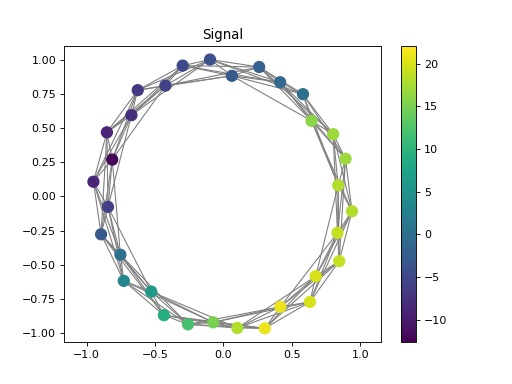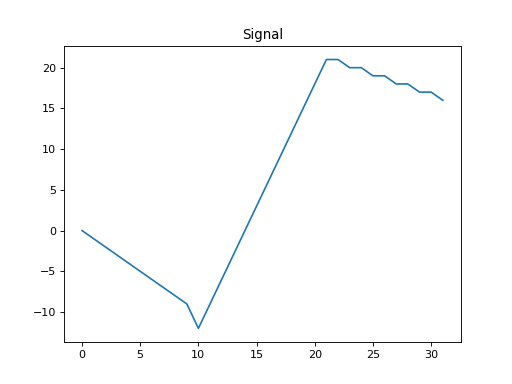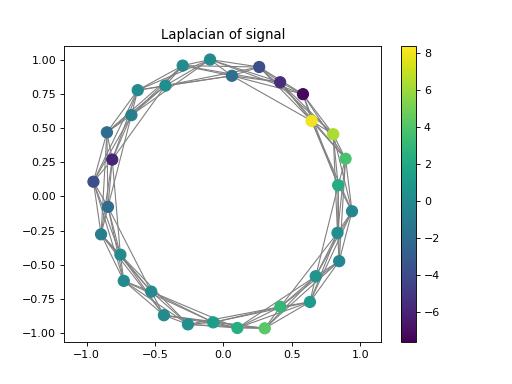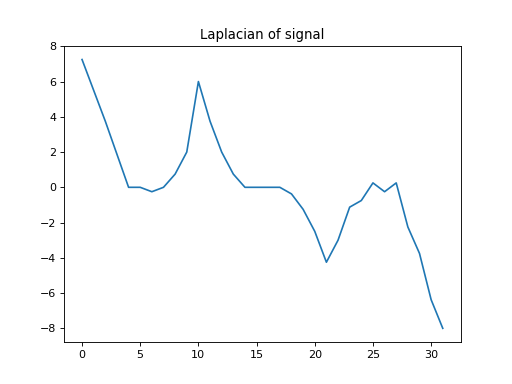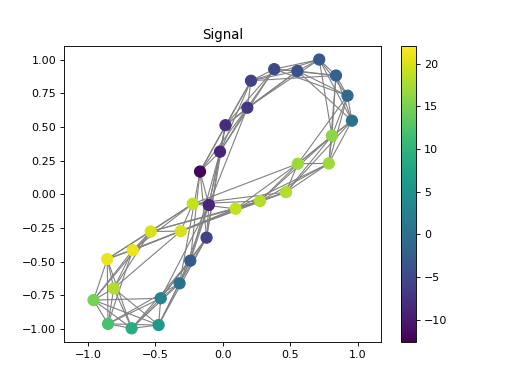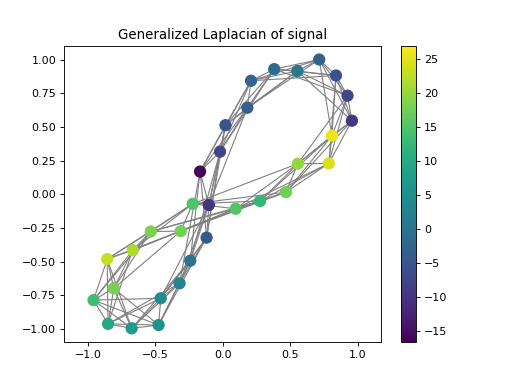Differential Operators¶
Module: pycgsp.linop.diff
Base class for graph convolution operators.
Graph differential operators.
|
Graph Laplacian. |
|
Graph gradient. |
|
Generalised graph Laplacian operator. |
-
class
GraphLaplacian(Graph: pygsp.graphs.graph.Graph, dtype: type = <class 'float'>)[source]¶ Bases:
pycsou.core.linop.LinearOperatorGraph Laplacian.
Normalised graph Laplacian for signals defined on graphs.
Examples
import numpy as np from pygsp.graphs import Ring from pycgsp.linop.diff import GraphLaplacian np.random.seed(1) G = Ring(N=32, k=4) G.compute_laplacian(lap_type='normalized') G.set_coordinates(kind='spring') x = np.arange(G.N) signal = np.piecewise(x, [x < G.N//3, (x >= G.N//3) * (x< 2 * G.N//3), x>=2 * G.N//3], [lambda x: -x, lambda x: 3 * x - 4 * G.N//3, lambda x: -0.5 * x + G.N]) Lap = GraphLaplacian(Graph=G) lap_sig = Lap * signal plt.figure() ax=plt.gca() G.plot_signal(signal, ax=ax, backend='matplotlib') plt.title('Signal') plt.axis('equal') plt.figure() plt.plot(signal) plt.title('Signal') plt.figure() ax=plt.gca() G.plot_signal(lap_sig, ax=ax, backend='matplotlib') plt.title('Laplacian of signal') plt.axis('equal') plt.figure() plt.plot(-lap_sig) plt.title('Laplacian of signal')
Notes
For undirected graphs, the normalized graph Laplacian is defined as
\[\mathbf{L} = \mathbf{I} - \mathbf{D}^{-1/2} \mathbf{W} \mathbf{D}^{-1/2},\]where \(\mathbf{I}\) is the identity matrix, \(\mathbf{W}\) is the weighted adjacency matrix and \(\mathbf{D}\) the weighted degree matrix.
For directed graphs, the Laplacians are built from a symmetrized version of the weighted adjacency matrix that is the average of the weighted adjacency matrix and its transpose. As the Laplacian is defined as the divergence of the gradient, it is not affected by the orientation of the edges.
For both Laplacians, the diagonal entries corresponding to disconnected nodes (i.e., nodes with degree zero) are set to zero.
The
GraphLaplacianoperator is self-adjoint.-
__init__(Graph: pygsp.graphs.graph.Graph, dtype: type = <class 'float'>)[source]¶ - Parameters
Graph (pygsp.graphs.Graph) – Graph on which the signal is defined, with normalised Laplacian
Graph.Lprecomputed (see pygsp.graphs.Graph.compute_laplacian(lap_type=’normalized’).dtype (type) – Type of the entries of the graph filer.
- Raises
AttributeError – If
Graph.Ldoes not exist.NotImplementedError – If
Graph.lap_typeis ‘combinatorial’.
-
-
class
GraphGradient(Graph: pygsp.graphs.graph.Graph, dtype: type = <class 'float'>)[source]¶ Bases:
pycsou.core.linop.LinearOperatorGraph gradient.
Gradient operator for signals defined on graphs.
Examples
>>> G = Ring(N=32, k=4) >>> G.compute_laplacian(lap_type='normalized') >>> G.compute_differential_operator() >>> G.set_coordinates(kind='spring') >>> x = np.arange(G.N) >>> signal = np.piecewise(x, [x < G.N//3, (x >= G.N//3) * (x< 2 * G.N//3), x>=2 * G.N//3], [lambda x: -x, lambda x: 3 * x - 4 * G.N//3, lambda x: -0.5 * x + G.N]) >>> Lap = GraphLaplacian(Graph=G) >>> Grad = GraphGradient(Graph=G) >>> lap_sig = Lap * signal >>> lap_sig2 = Grad.adjoint(Grad(signal)) >>> np.allclose(lap_sig, lap_sig2) True
Notes
The adjoint of the
GraphGradientoperator is called the graph divergence operator.Warning
In the newest version of PyGSP (> 0.5.1) the convention is changed:
Graph.Dis the divergence operator andGraph.D.transpose()the gradient (see routine Graph.compute_differential_operator). The code should be adapted when this new version is released.See also
-
__init__(Graph: pygsp.graphs.graph.Graph, dtype: type = <class 'float'>)[source]¶ - Parameters
Graph – Graph on which the signal is defined, with differential operator
Graph.Dprecomputed (see pygsp.graphs.Graph.compute_differential_operator().dtype (type) – Type of the entries of the graph filer.
- Raises
AttributeError – If
Graph.Ddoes not exist.
-
-
GeneralisedGraphLaplacian(Graph: pygsp.graphs.graph.Graph, kind: str = 'iterated', **kwargs)[source]¶ Generalised graph Laplacian operator.
Generalised Laplacian operator signals defined on graphs.
- Parameters
Graph –
Graph on which the signal is defined, with normalised Laplacian
Graph.Lprecomputed (see pygsp.graphs.Graph.compute_laplacian(lap_type=’normalized’).dtype (type) – Type of the entries of the graph filer.
kind (str) –
Type of generalised differential operator (
'iterated','sobolev','polynomial'). Depending on the cases, theGeneralisedLaplacianoperator is defined as follows:'iterated': \(\mathscr{D}=\mathbf{L}^N\),'sobolev': \(\mathscr{D}=(\alpha^2 \mathrm{Id}-\mathbf{L})^N\), with \(\alpha\in\mathbb{R}\),'polynomial': \(\mathscr{D}=\sum_{n=0}^N \alpha_n \mathbf{L}^n\), with \(\{\alpha_0,\ldots,\alpha_N\} \subset\mathbb{R}\),
where \(\mathbf{L}\) is the
GraphLaplacianoperator.kwargs (Any) –
Additional arguments depending on the value of
kind:'iterated':kwargs={order: int}whereorderdefines the exponent \(N\).'sobolev':kwargs={order: int, constant: float}whereorderdefines the exponent \(N\) andconstantthe scalar \(\alpha\in\mathbb{R}\).'polynomial':kwargs={coeffs: Union[np.ndarray, list, tuple]}wherecoeffsis an array containing the coefficients \(\{\alpha_0,\ldots,\alpha_N\} \subset\mathbb{R}\).
- Raises
AttributeError – If
Graph.Ldoes not exist.NotImplementedError – If
Graph.lap_typeis ‘combinatorial’.NotImplementedError – If
kindis not ‘iterated’, ‘sobolev’ or ‘polynomial’.
Examples
import numpy as np from pygsp.graphs import Ring from pycgsp.linop.diff import GeneralisedGraphLaplacian np.random.seed(1) G = Ring(N=32, k=4) G.compute_laplacian(lap_type='normalized') G.set_coordinates(kind='spring') x = np.arange(G.N) signal = np.piecewise(x, [x < G.N//3, (x >= G.N//3) * (x< 2 * G.N//3), x>=2 * G.N//3], [lambda x: -x, lambda x: 3 * x - 4 * G.N//3, lambda x: -0.5 * x + G.N]) Dop = GeneralisedGraphLaplacian(Graph=G, kind='polynomial', coeffs=[1,-1,2]) gen_lap = Dop * signal plt.figure() ax=plt.gca() G.plot_signal(signal, ax=ax, backend='matplotlib') plt.title('Signal') plt.axis('equal') plt.figure() ax=plt.gca() G.plot_signal(gen_lap, ax=ax, backend='matplotlib') plt.title('Generalized Laplacian of signal') plt.axis('equal')
Notes
The
GeneralisedGraphLaplacianoperator is self-adjoint.See also
